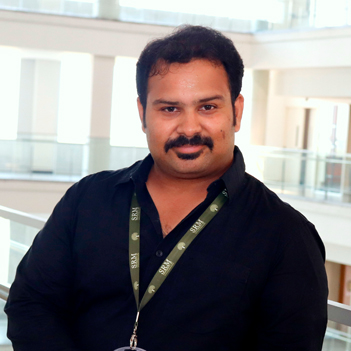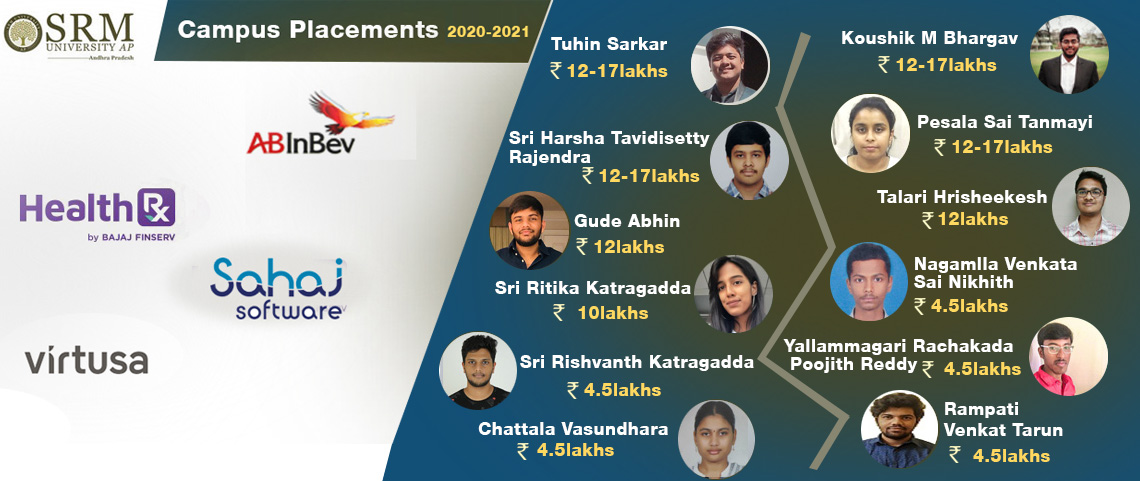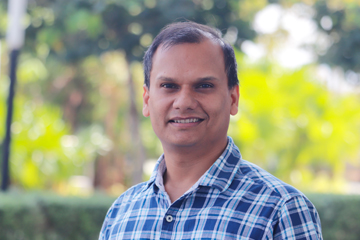SRM AP faculty receives the prestigious grant by DBT/Wellcome Trust India Alliance
Investigating giant bacterial viruses to explore the origin of cellular complexity
 Dr. Sutharsan Govindarajan, Assistant Professor, Department of Biological Sciences, SRM University-AP has been awarded the prestigious ‘Early Career Fellowship’ grant by DBT/Wellcome Trust India Alliance, funded by the Department of Biotechnology (DBT) and the Wellcome Trust, United Kingdom. The fellowship supports outstanding young scientists to pursue high-quality research in the field of biomedical science and establish themselves as independent researchers in India. Dr. Sutharsan sought a total research grant of 1.1 crore for a period of 5 years as a DBT/Wellcome Trust India Alliance Early career fellow. The India Alliance grants are highly competitive and is based on the profile of the applicant and the novelty and the importance of the proposed research. Nationwide only less than 10 Early Career grants are awarded every year. Dr Sutharsan is a highly accomplished scientist, having published research articles in highly reputed journals, including the most prestigious Nature and Nature Microbiology. Through this fellowship, Dr. Sutharsan will establish an independent research laboratory at SRM University – AP with the support of Prof. Jayaseelan, Head, Department of Biological Sciences, and the fellowship supervisor of the project.
Dr. Sutharsan Govindarajan, Assistant Professor, Department of Biological Sciences, SRM University-AP has been awarded the prestigious ‘Early Career Fellowship’ grant by DBT/Wellcome Trust India Alliance, funded by the Department of Biotechnology (DBT) and the Wellcome Trust, United Kingdom. The fellowship supports outstanding young scientists to pursue high-quality research in the field of biomedical science and establish themselves as independent researchers in India. Dr. Sutharsan sought a total research grant of 1.1 crore for a period of 5 years as a DBT/Wellcome Trust India Alliance Early career fellow. The India Alliance grants are highly competitive and is based on the profile of the applicant and the novelty and the importance of the proposed research. Nationwide only less than 10 Early Career grants are awarded every year. Dr Sutharsan is a highly accomplished scientist, having published research articles in highly reputed journals, including the most prestigious Nature and Nature Microbiology. Through this fellowship, Dr. Sutharsan will establish an independent research laboratory at SRM University – AP with the support of Prof. Jayaseelan, Head, Department of Biological Sciences, and the fellowship supervisor of the project.
In this project, Dr. Sutharsan plans to venture and explore the biology of a novel class of bacteriophages called Jumbo-phages. “Bacteriophages, which are the most abundant biological entities on the planet, are viruses that infect bacteria but do not harm humans. Jumbo-phages, as the name suggests, are giant viruses with large genome. A sneak peek into their lifestyle during my postdoctoral research led me, to realize that these phages build fascinating complex structures inside the bacteria they infect. Such complex structures are well known to be formed in eukaryotic cells like human cells but was not thought to be made by bacteriophages, which have evolved billions of years before eukaryotes. Thus, studying how such cellular structures are formed by jumbo-phages provides a unique opportunity to investigate the origin of complex life” informs Dr. Sutharsan. He also explains that the proposed research has several biotechnological applications such as phage therapy and synthetic biology.
Dr. Sutharsan further shares, “This is one the best fellowships, a young scientist can obtain in India. It is an honour, prestige and a recognition for the scientist as well as to the University. In the next 5 years, I anticipate major fundamental discoveries in the field of bacteriophage biology and evolution”.
- Published in News, Research News
Campus Placements 2020-2021
12 brilliant students of SRM AP lands up with excellent job offers to initiate the Campus Recruitment Drive

SRM University-AP, Andhra Pradesh has commenced its journey to secure a better future for the first batch of students. Promising students of SRM AP have grabbed excellent job offers in the Campus Recruitment Drive for Class 2021 B.Tech students. Anheuser-Busch InBev offered 6 months internship, followed by a job offer to outstanding candidates. The company shortlisted Pesala Sai Tanmayi, Sri Harsha Tavidisetty Rajendra, Tuhin Sarkar, and Koushik M Bhargav. Anheuser -Busch InBev SA/NV, commonly known as AB InBev is a Belgian multinational drink and brewing company. The company has offered an internship stipend of 30 thousand per month and a CTC of 12-17 LPA to the candidates who will join the company after successful completion of their internship.
Another renowned company Health Rx, which innovates and develops secure web-based and mobile solutions to streamline information flow in the clinical and research environments, has offered Technical Internship with a stipend of 35 thousand per month, and post that a confirmed job offer with CTC of 12 LPA to Talari Hrisheekesh, and Gude Abhin. Further, VIRTUSA Corporation, an American IT service provider, offered a position in the company with a CTC of 4.5-6.5 LPA to Yallammagari Rachakada Poojith Reddy, Nagamlla Venkata Sai Nikhith, Chattala Vasundhara, Rampati Venkat Tarun, and Sai Rishvanth Katragadda. The other company which conducted the recruitment drive at SRM AP, Sahaj Soft, selected Sri Ritika Katragadda and offered her a CTC of 10 LPA. Sahaj Soft is a software services and consulting firm which provides simple solutions backed by their time-tested methodology and engineering practices.
As the recruiters shortlist the best young talent who are enthusiastic, devoted to learning and brimming with fresh and creative ideas, SRM AP placement team have thoroughly trained the students both in terms of technical expertise and soft skills. The rigorous training that the students underwent since the beginning of their B. Tech course, coupled with their talent and motivation, has enabled them to succeed in recruitment drive with flying colours. SRM AP believes that this is merely the beginning of the placement season, and many more brilliant students are waiting to showcase their mettle to land up with excellent job offers in top-notch companies.
- Published in CR&CS NEWS, News
Energy-Efficiency Optimization over Full-Duplex IoT Networks Towards Commercial Applications
 Dr Om Jee Pandey Two research papers of Dr Om Jee Pandey, Assistant Professor, Department of Electronics and Communication Engineering, have been accepted in reputed IEEE Journals. The papers titled “Multiuser Full-Duplex IoT Networks with Wireless-Powered Relaying: Performance Analysis and Energy Efficiency Optimization,” and “Time Synchronized Node Localization Using Optimal H-Node Allocation in a Small World WSN” are going to be published in IEEE Transactions on Green Communications and Networking and IEEE Communications Letters, respectively. The paper “Multiuser Full-Duplex IoT Networks with Wireless-Powered Relaying: Performance Analysis and Energy Efficiency Optimization,” was pursued in collaborations with Prof. Ha H. Nguyen, Department of Electrical and Computer Engineering, University of Saskatchewan, Saskatoon, Canada, and Dr Mahendra K. Shukla, who is associated with Macau University of Science and Technology as a Post Doctoral Fellow.
Dr Om Jee Pandey Two research papers of Dr Om Jee Pandey, Assistant Professor, Department of Electronics and Communication Engineering, have been accepted in reputed IEEE Journals. The papers titled “Multiuser Full-Duplex IoT Networks with Wireless-Powered Relaying: Performance Analysis and Energy Efficiency Optimization,” and “Time Synchronized Node Localization Using Optimal H-Node Allocation in a Small World WSN” are going to be published in IEEE Transactions on Green Communications and Networking and IEEE Communications Letters, respectively. The paper “Multiuser Full-Duplex IoT Networks with Wireless-Powered Relaying: Performance Analysis and Energy Efficiency Optimization,” was pursued in collaborations with Prof. Ha H. Nguyen, Department of Electrical and Computer Engineering, University of Saskatchewan, Saskatoon, Canada, and Dr Mahendra K. Shukla, who is associated with Macau University of Science and Technology as a Post Doctoral Fellow.
 Block diagram of the full-duplex
Block diagram of the full-duplex
wireless-powered relay based on power splitting There has been a growing interest in improving energy efficiency for next-generation Internet of Things (IoT) networks due to the increasing demand for green communications. Motivated by this demand, energy efficiency maximization has been investigated for several networks. Specifically, without considering simultaneous wireless information and power transfer networks, various works have extensively studied energy efficiency maximization for half-duplex networks and full-duplex networks. Further, by considering simultaneous wireless information and power transfer networks, several works have examined energy efficiency maximization in half-duplex networks. Moreover, energy efficiency for next-generation IoT networks with simultaneous wireless information and power transfer has also been studied by considering half-duplex transceivers. It appears that energy efficiency problems for multiuser full-duplex IoT networks have not been studied in the open literature.
 Multiuser FD-IoT network with
Multiuser FD-IoT network with
wireless-powered TWR Motivated by the above discussion, in this work we consider a full-duplex IoT network in which a multi-antenna access point and several single antenna IoT devices exchange information bidirectionally with the aid of a wireless-powered single-antenna relay, under generalized Nakagami-m fading channels. In particular, we consider the power splitting protocol at the full-duplex relay terminal, and each communication terminal operates in the full-duplex mode. For such a network, we first formulate the instantaneous end-to-end signal-to-interference-plus-noise ratios (SINRs) by employing maximum-ratio transmission (MRT) beamforming and maximum-ratio combining (MRC) at the access point A, as well as IoD scheduling. Then, based on the obtained SINRs, we evaluate the overall outage probability and ergodic sum-rate of the network. Furthermore, we develop an optimal power allocation to maximize the network’s EE.
 Integral area for the
Integral area for the
overall outage probability Recently, with many technological advancements in wireless data transmission, IoT is expected to affect all aspects of our daily lives with its ever-growing and emerging applications. Traditional wireless communication networks are usually limited by the operational time of energy-constrained devices, and therefore energy consumption minimization is a crucial factor in IoT networks. Simultaneous wireless information and power transfer have emerged as a sustainable solution to the scenarios where replacing or recharging batteries is very costly, and may even be impossible. The basic idea of simultaneous wireless information and power transfer is that since radio frequency signals can carry information and energy at the same time, the received radio frequency signals can be utilized for energy harvesting to keep the energy-constrained devices operational. Existing studies adopt two different protocols, namely time switching and power switching, to implement simultaneous wireless information and power transfer receiver architecture. With these protocols, either the power or time of the received signal is split so that one part is used for information processing, and the other is used for energy harvesting.
The proposed research can play a crucial role in societal development as it can be applied in developing many state-of-the-art applications in the areas related to green healthcare systems, energy-efficient agriculture systems, green transportation, low power home automation, green manufacturing, low power smart utilities, and energy-efficient industries etc.
His other paper “Time Synchronized Node Localization Using Optimal H-Node Allocation in a Small World WSN”, DOI (identifier) 10.1109/LCOMM.2020.3008086, has been done in collaborations with Prof. Rajesh M Hegde, Department of Electrical Engineering, IIT Kanpur and Dr Mahendra K. Shukla, Post Doctoral Fellow at Macau University of Science and Technology. To know more about Dr Pandey’s work in the domain of Small-World Wireless Sensor Network, visit- https://srmap.edu.in/news/dr-om-jee-pandey-small-world-wireless-sensor-network-help-making-smart-applications-industries/.
Dr Pandey is now not only working for the commercial applications of his current research but also has devoted himself to his future projects, that include-
Full-Duplex Network Development for Green Healthcare Systems.
Energy-Efficient Cyber-Physical Systems and Internet of Things.
Development of Energy-Efficient Agriculture Systems.
Green and Intelligent Transportation over Full-Duplex Context-Aware Pervasive Systems.
- Published in ECE NEWS, Faculty, News, Research News
Campus Placements 2020-2021
Brilliant students of SRM AP lands up with excellent job offers to initiate the Campus Recruitment Drive

SRM University-AP, Andhra Pradesh has commenced its journey to secure a better future for the first batch of students. Promising students of SRM AP have grabbed excellent job offers in the Campus Recruitment Drive for Class 2021 B.Tech students. The renowned company which conducted the recruitment drive at SRM AP, Amazon, selected Sri Ritika Katragadda and Venkata Sai Nikhith Nagamlla for an internship with a stipend of 45 thousand leading to job offer with a CTC of 29.5 LPA based on performance. In addition, Sai Rishvanth Katragadda, shone in the recruitment drive conducted by PayPal who offered the brilliant student a package of 24 LPA for the position of Software Engineer. PayPal is a reputed company that provides a worldwide online payment system, online money transfers, and serves as an electronic alternative to traditional paper methods. Another renowned company, Anheuser-Busch InBev offered 6 months internship, followed by a job offer to outstanding candidates. The company shortlisted Pesala Sai Tanmayi, Sri Harsha Tavidisetty Rajendra, Tuhin Sarkar, and Koushik M Bhargav. Anheuser -Busch InBev SA/NV, commonly known as AB InBev is a Belgian multinational drink and brewing company. The company has offered an internship stipend of 30 thousand per month and a CTC of 12-17 LPA to the candidates who will join the company after successful completion of their internship.
Moving ahead, Health Rx, a health care startup of Bajaj finserv group, has offered Technical Internship with a stipend of 35 thousand per month, and on successful completion a job offer with CTC of 12 LPA to Talari Hrisheekesh, and Gude Abhin will be released. Also, Alluri Harika received an offer from Optum Global Solutions, a health services and innovation company, with a package of 12 LPA. Further, Aayusi Biswas got placed at Sabre Corporation in the position of an Associate Software Engineer. In this revered company operating in the travel technology sector, Aayushi will be receiving a CTC of 10 LPA. Also, the leading multinational investment bank and financial services company, Barclays, hosted recruitment drive at SRM AP and offered job offers to Bhaskarani Sharath Chandra Kumar, and Mohammad Nilofer Sultana with a package of 10 LPA. Advancing with the recruitment drive, ZS Associates, a professional service providing firm focusing on consulting, software, and technology recruited Vatsal Rathod, and Pushya Mitra K with a CTC of 10 LPA. Alongside, Gaddam Akhileshwar Reddy got placed at Veritas Technologies LLC., an American international data management company with a package of 10 LPA.
Advancing with the placement season, a company named Amadeus selected Gumadavelly Ramya and Sai Krishna Rohith Kattamuri with a CTC of 10 LPA. Amadeus is a travel technology company that provides the critical solutions for airlines and airports, hotels and railways, search engines, travel agencies, tour operators and other travel players to run their operations and improve the travel experience. Similarly, Coviam Technology, an innovative technology start-up, selected G Adarsh, Sai Rishvanth Katragadda, Jashwanth Reddy Dodda, and Jonnalagadda Noyal for an initial internship offer with a stipend of 25 thousand per month, which will be converted to a job offer with a CTC of 7.5 LPA. In addition, Opentext, a Canadian company that develops and sells enterprise information management software, has offered an internship opportunity with a stipend of Rs. 15 thousand, post completion of which, the two students Rampati Venkata Tarun, And Neelakantam Poorna Venkat, will be placed with a CTC of 7.25 LPA.
Progressing with the recruitment drive, several reputed companies such as Walmart Labs, Standard Chartered , L&T Technology Services Ltd, Amdocs, Virtusa Corporation, Legato Health Technologies LLP, Infosys Limited, and Cerner Corporation IT, selected more than 10 students with an annual package up to 7 LPA. As the recruiters shortlist the best young talent who are enthusiastic, devoted to learning and brimming with fresh and creative ideas, SRM AP placement team have thoroughly trained the students both in terms of technical expertise and soft skills. The rigorous training that the students underwent since the beginning of their B. Tech course, coupled with their talent and motivation, has enabled them to succeed in recruitment drive with flying colours. SRM AP believes that this is merely the beginning of the placement season, and many more brilliant students are waiting to showcase their mettle to land up with excellent job offers in top-notch companies.
- Published in News

